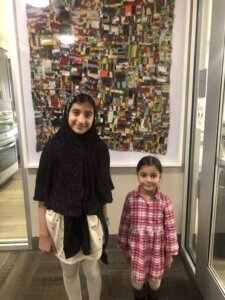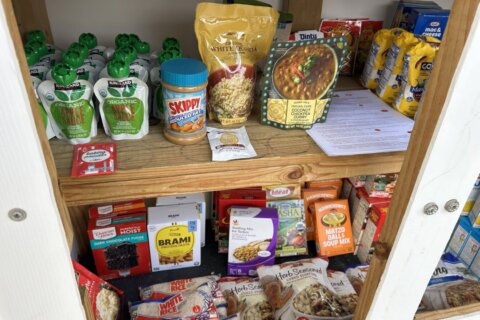A quilt of many colors and textures, carefully selected and meticulously stitched together by kids in collaboration with Newport News-based artist Asa Jackson, earned a spot earlier this year at the Museum of Contemporary Art Arlington.
The quilt was put on permanent display Wednesday in the children’s home — Columbia Hills Apartments — which is home to many diverse families served by Arlington Partnership for Affordable Housing (APAH). Other pieces of colorful contemporary art grace the bright hallways of the eight-floor building, which has more than 200 units of affordable housing.
“At many of APAH’s properties, we have taken it upon ourselves to provide public art as part of what beautifies the space, what makes the space alive. It’s something that our residents see on a day-to-day basis and it brings a sense of light, encouragement, peace and joy into the spaces,” said Garrett Jackson, the director of resource development and communications for APAH.
Under a $35,000 grant from the National Endowment for the Arts, Arlington Art teamed with MoCA Arlington to retain textile artist Asa Jackson for the project.
Ten-year-old Aylena Junaid, a student at Arlington Traditional Elementary School, said Jackson guided her and the other kids through the process of using the sewing machine.
“He would ask us which fabric we wanted to use … and we would pick lots of different types and then everyone would pick any fabric they would want and then they would … put it all together and then create a big quilt … so it was really fun,” Junaid said. “I really liked it and I really want more art classes.”

The county turned to the 49-year-old Museum of Contemporary Art Arlington to help with the project.
Catherine Anchin, executive director of MoCA Arlington, said her team chose Jackson to lead the project. He came up to Arlington nearly every week to do workshops with the families.
“His work is fantastic. He’s included in a lot of museums already. He asked the community to bring textiles that help tell their story,” Anchin said. “And, because this building has so many residents from all around the world, kids and adults would bring in their textiles and he taught them how to sew and they would create this collaborative quilt together … the final piece is now on view for the residents to enjoy indefinitely.”
The county wants to expand the public art program into more affordable housing properties.
“My favorite part of the project was seeing the community come together through the actual artwork, through the quilt-making, through the workshops — that these different cultures are able to speak to each other,” said Tomora Wright, public art project manager for Arlington’s Cultural Affairs Division.








